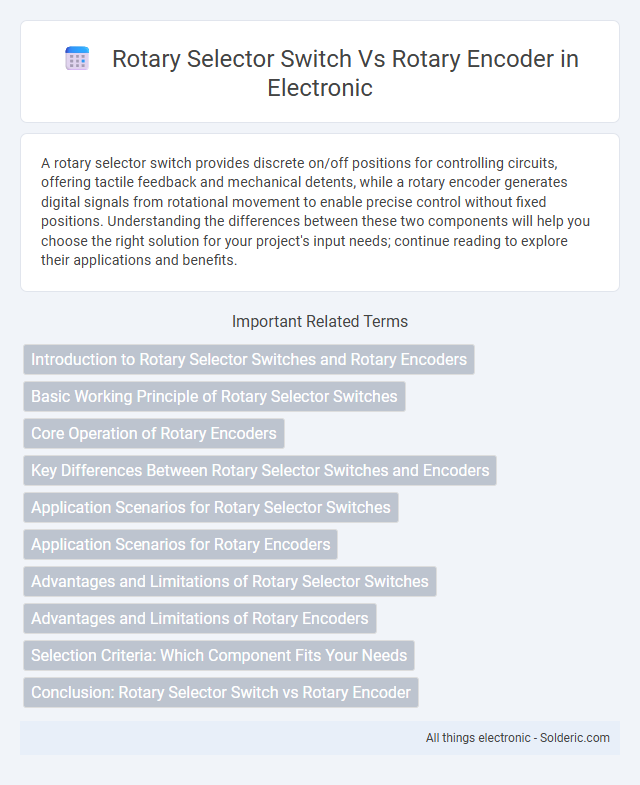A rotary selector switch provides discrete on/off positions for controlling circuits, offering tactile feedback and mechanical detents, while a rotary encoder generates digital signals from rotational movement to enable precise control without fixed positions. Understanding the differences between these two components will help you choose the right solution for your project's input needs; continue reading to explore their applications and benefits.
Comparison Table
| Feature | Rotary Selector Switch | Rotary Encoder |
|---|---|---|
| Function | Mechanical switch to select fixed positions | Sensor to detect rotational position and direction |
| Output Type | Discrete electrical contacts (on/off) | Digital pulses or analog signals |
| Position Feedback | Physical, fixed number of positions | Continuous or incremental feedback |
| Applications | Mode selection, manual settings | Position sensing, user input in electronics |
| Durability | Mechanical wear due to contacts | Longer lifespan, contactless options available |
| Complexity | Simple wiring and operation | Requires signal processing and decoding |
| Cost | Generally lower cost | Higher cost due to electronics |
Introduction to Rotary Selector Switches and Rotary Encoders
Rotary selector switches provide discrete position control by mechanically selecting predefined circuits or settings, commonly utilized in industrial control panels for mode selection. Rotary encoders offer continuous feedback by converting angular position or motion into digital signals, enabling precise measurement and control in applications such as robotics and automation. Both components are essential in electronic systems, differing primarily in functionality: selector switches act as on/off or select inputs, while encoders deliver high-resolution positional data.
Basic Working Principle of Rotary Selector Switches
Rotary selector switches operate by physically connecting one of several contacts to a common terminal as the knob is turned, enabling discrete circuit selections. Each detent position corresponds to a fixed electrical pathway, making them ideal for manually selecting specific predefined functions in industrial and electronic applications. Unlike rotary encoders, selector switches provide direct mechanical feedback and maintain a stable contact position without requiring electronic signal processing.
Core Operation of Rotary Encoders
Rotary encoders operate by converting the angular position or motion of a shaft into an electronic signal, using optical or magnetic sensing technology to detect rotational changes. Unlike rotary selector switches that mechanically select discrete positions, rotary encoders provide continuous position feedback with high precision, enabling fine control in applications such as robotics, industrial machinery, and volume control in audio equipment. The core operation involves generating pulse signals corresponding to shaft rotation, which are interpreted by controllers for accurate measurement of speed, direction, and position.
Key Differences Between Rotary Selector Switches and Encoders
Rotary selector switches provide discrete on/off positions, allowing users to manually select fixed settings, while rotary encoders output continuous or incremental signals for precise position tracking. Selector switches are often used for simple, mechanical control applications, whereas rotary encoders enable digital feedback and are integral in automation and robotics for accurate motion control. The key difference lies in selector switches' electrical contact changes versus encoders' electronic signal generation for rotational position sensing.
Application Scenarios for Rotary Selector Switches
Rotary selector switches are commonly used in industrial machinery for selecting operational modes or controlling power circuits due to their robust mechanical design and clear positional feedback. These switches excel in environments requiring reliable, tactile input for functions such as motor starter control, equipment configuration, and multi-speed fan settings. Their simplicity and durability make them ideal for applications demanding straightforward, manual selection without the need for digital signal processing.
Application Scenarios for Rotary Encoders
Rotary encoders are extensively used in precision control systems such as robotics, CNC machines, and industrial automation due to their ability to provide accurate position feedback and speed measurement. Their applications extend to consumer electronics like volume controls and computer input devices where fine, incremental adjustments are needed. Unlike rotary selector switches that simply select preset options, rotary encoders enable dynamic adjustment, making them ideal for scenarios requiring continuous rotational input and precise control.
Advantages and Limitations of Rotary Selector Switches
Rotary selector switches offer robust mechanical feedback and straightforward operation, making them ideal for applications requiring distinct, fixed position selection with high durability and low susceptibility to electrical noise. However, they are limited by fewer position options, lack of continuous rotation capability, and no digital output signal, which restricts their integration with advanced electronic systems. Their simplicity benefits industrial controls but can hinder flexibility and precision in complex or programmable environments.
Advantages and Limitations of Rotary Encoders
Rotary encoders offer precise position feedback, making them ideal for applications requiring accurate angular measurements and speed control, unlike rotary selector switches which primarily provide discrete position selection. Their high resolution and ability to enable continuous rotation without stop points allow for smooth, variable control in complex systems. However, rotary encoders may require more complex signal processing and are susceptible to electrical noise, potentially affecting reliability in harsh environments.
Selection Criteria: Which Component Fits Your Needs
Rotary selector switches offer tactile feedback and definitive mechanical positions, making them ideal for applications requiring precise, reliable on/off or multi-position selections. Rotary encoders provide continuous rotation and high-resolution position feedback, suitable for tasks needing smooth control and incremental adjustments. Choosing between them depends on whether your system prioritizes discrete, stable selections or fine, variable input control.
Conclusion: Rotary Selector Switch vs Rotary Encoder
Rotary selector switches provide precise, discrete position selection ideal for fixed settings in industrial and consumer applications, while rotary encoders offer continuous position feedback essential for accurate motion control and digital interfaces. Selector switches are mechanical with distinct stopping points, ensuring reliable manual input with tactile feedback, whereas rotary encoders utilize optical or magnetic sensors to deliver high-resolution rotational data for automated systems. Choosing between the two depends on the requirement for either fixed, discrete control or dynamic, high-precision position sensing in the target application.
rotary selector switch vs rotary encoder Infographic

 solderic.com
solderic.com